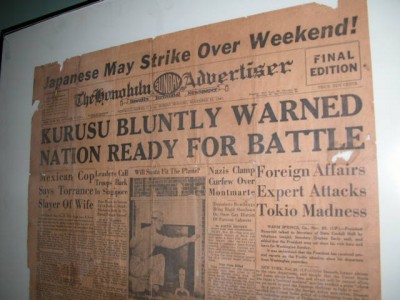Did FDR Provoke Pearl Harbor?

On Dec. 8, 1941, Franklin Roosevelt took the rostrum before a joint session of Congress to ask for a declaration of war on Japan.
A day earlier, at dawn, carrier-based Japanese aircraft had launched a sneak attack devastating the U.S. battle fleet at Pearl Harbor.
Said ex-President Herbert Hoover, Republican statesman of the day, “We have only one job to do now, and that is to defeat Japan.”
But to friends, “the Chief” sent another message: “You and I know that this continuous putting pins in rattlesnakes finally got this country bit.”
Today, 70 years after Pearl Harbor, a remarkable secret history, written from 1943 to 1963, has come to light. It is Hoover’s explanation of what happened before, during and after the world war that may prove yet the death knell of the West.
Edited by historian George Nash, Freedom Betrayed: Herbert Hoover’s History of the Second World War and Its Aftermath is a searing indictment of FDR and the men around him as politicians who lied prodigiously about their desire to keep America out of war, even as they took one deliberate step after another to take us into war.
Yet the book is no polemic. The 50-page run-up to the war in the Pacific uses memoirs and documents from all sides to prove Hoover’s indictment. And perhaps the best way to show the power of this book is the way Hoover does it — chronologically, painstakingly, week by week.
Consider Japan’s situation in the summer of 1941. Bogged down in a four-year war in China she could neither win nor end, having moved into French Indochina, Japan saw herself as near the end of her tether.
Inside the government was a powerful faction led by Prime Minister Prince Fumimaro Konoye that desperately did not want a war with the United States.
The “pro-Anglo-Saxon” camp included the navy, whose officers had fought alongside the U.S. and Royal navies in World War I, while the war party was centered on the army, Gen. Hideki Tojo and Foreign Minister Yosuke Matsuoka, a bitter anti-American.
On July 18, 1941, Konoye ousted Matsuoka, replacing him with the “pro-Anglo-Saxon” Adm. Teijiro Toyoda.
The U.S. response: On July 25, we froze all Japanese assets in the United States, ending all exports and imports, and denying Japan the oil upon which the nation and empire depended.
Stunned, Konoye still pursued his peace policy by winning secret support from the navy and army to meet FDR on the U.S. side of the Pacific to hear and respond to U.S. demands.
U.S. Ambassador Joseph Grew implored Washington not to ignore Konoye’s offer, that the prince had convinced him an agreement could be reached on Japanese withdrawal from Indochina and South and Central China. Out of fear of Mao’s armies and Stalin’s Russia, Tokyo wanted to hold a buffer in North China.
On Aug. 28, Japan’s ambassador in Washington presented FDR a personal letter from Konoye imploring him to meet.
Tokyo begged us to keep Konoye’s offer secret, as the revelation of a Japanese prime minister’s offering to cross the Pacific to talk to an American president could imperil his government.
On Sept. 3, the Konoye letter was leaked to the Herald-Tribune.
On Sept. 6, Konoye met again at a three-hour dinner with Grew to tell him Japan now agreed with the four principles the Americans were demanding as the basis for peace. No response.
On Sept. 29, Grew sent what Hoover describes as a “prayer” to the president not to let this chance for peace pass by.
On Sept. 30, Grew wrote Washington, “Konoye’s warship is ready waiting to take him to Honolulu, Alaska, or anyplace designated by the president.”
No response. On Oct. 16, Konoye’s cabinet fell.
In November, the U.S. intercepted two new offers from Tokyo: a Plan A for an end to the China war and occupation of Indochina and, if that were rejected, a Plan B, a modus vivendi where neither side would make any new move. When presented, these, too, were rejected out of hand.
At a Nov. 25 meeting of FDR’s war council, Secretary of War Henry Stimson’s notes speak of the prevailing consensus: “The question was how we should maneuver them [the Japanese] into … firing the first shot without allowing too much danger to ourselves.”
“We can wipe the Japanese off the map in three months,” wrote Navy Secretary Frank Knox.
As Grew had predicted, Japan, a “hara-kiri nation,” proved more likely to fling herself into national suicide for honor than to allow herself to be humiliated
Out of the war that arose from the refusal to meet Prince Konoye came scores of thousands of U.S. dead, Hiroshima, Nagasaki, the fall of China to Mao Zedong, U.S. wars in Korea and Vietnam, and the rise of a new arrogant China that shows little respect for the great superpower of yesterday.
If you would know the history that made our world, spend a week with Mr. Hoover’s book.

